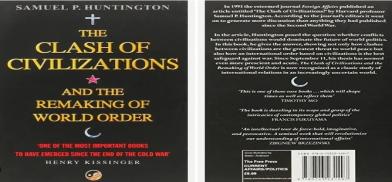Clash of Civilizations: Which will be the best-placed to lead the world?
India and China represent the future, America (West) the present, and Europe the past; Islam has a long way to go.

The phrase "The Clash of Civilizations" was first used by Albert Camus in 1946, by Times of India editor Girilal Jain in his analysis of the Ayodhya dispute in 1988, and by many others subsequently. It was much later that the phrase came to be widely discussed.
The "Clash of Civilizations" is a thesis by the American political scientist Samuel P Huntington in which he argues people's cultural and religious identities will be the primary source of conflict in the post–Cold War world and followed up in a lecture in 1992 at the American Enterprise Institute, that future wars would be fought not between countries, but between cultures. It was later developed in a 1993 article titled "The Clash of Civilizations?", in response to his former student Francis Fukuyama’s 1992 book “The End of History and the Last Man”. But it was only years later when the world took a fancy to the phrase when Huntington expanded his thesis in a 1996 book "The Clash of Civilizations and the Remaking of World Order". At the end of his 1993 Foreign Affairs article, "The Clash of Civilizations?", Huntington writes, "This is not to advocate the desirability of conflicts between civilizations. It is to set forth a descriptive hypothesis as to what the future may be like."
Many of the individual arguments about the specifics of the “clash of civilizations” didn’t get at the larger point, which is really about how much culture matters as opposed to geopolitics or economics or ideology. Nor do civilizations appear to have an important indirect influence on interstate conflict through the realist or liberal variables. Except to loosely predict alliance patterns it makes little contribution to explaining political institutions or commercial interactions. Huntington challenged us to consider the role that civilizations might play in international relations, but there is little evidence that they define the fault lines along which international conflicts are occurring.
1. The USA-Iran is not a clash of civilizations more than the USA not wanting Iran to have nukes and have a say in the geopolitics of Central Asia, a confluence of warm waters, Europe and Asia, so important for economic activities.
2. The Russian–Ukraine conflict is obviously for territory and not a clash of civilizations.
3. The Israel- Arab (Hamas, Hezbollah, Iran or whoever) is more as Palestinians against Israel (occupier) as also Israel is perceived as a hindrance to Iran’s hegemony in the area (with the nukes when it gets)
4. Neither are conflicts in Sudan, Libya, Syria, Iraq etc. clash of civilizations.
5. The Indo-China conflicts, Indo-Pak wars, the Korean War, China’s predatory eye on Taiwan, South China Sea are all not a clash of civilizations.
Real clash of civilizations
The differences among civilizations are too basic in that civilizations are differentiated from each other by history, language, culture, tradition, and, most importantly, religion. These fundamental differences are the product of centuries and the foundations of different civilizations, meaning they will not be gone soon. The world is becoming a smaller place. Due to economic modernization and social change, people are separated from long-standing local identities. Interactions between civilizations are increasing with commitments that transcend national boundaries and unite civilizations. Economic regionalism is increasing. Successful economic regionalism will reinforce civilization-consciousness. Yet, economic regionalism may succeed only when it is rooted in a common civilization.
By this logic, the four prominent civilizations to be reckoned with today are the West (led by the USA), India, China and Islam.
Western: The Western civilization has been largely shaped by ancient Greece and Rome which spread to Europe and after evolving took roots in the colonies of America which became the center of gravity of the West. West also includes Latin America, Russia and Australia though Australia is changing ethnically. The USA is a declining power which too will become a nonwhite majority state in a few decades. The non-white USA will continue to follow a foreign policy of ruthless self-interest in Asia to secure its geopolitical goals. Western leaders wedded to democracy at home and cozying up to pliant dictators abroad to find a moral escape route in the Middle East on the fraudulent pretext of preserving the region’s historical stability are treading on thin ice. Though the influence and economy of the USA are on the decline, the West will continue to influence.
India: India is deeply rooted in history and is a growing hard and soft power. India has a widely dispersed diaspora with the center of gravity geographically well set in India, with a strong demographics of the working population; soon to be third largest economy; a confluence of cultures as nowhere else, diversity and democracy. Amidst a challenging global scenario, India has emerged as a significant economic and geopolitical power. Its actions in the coming year could lay the groundwork for the country to become the world’s third-largest economy in the next five years and a developed nation by 2047, setting an example of inclusive, sustainable economic growth, digital development and climate action. This is the time for India to strike – diplomatically – Africa Latin America, Russia etc
China: China deeply rooted in history, will continue to rise, influencing from the Pacific to Africa. It is the second largest economy with the center of gravity being China. China’s economy is going through a rough time, given its resilience it has the potential to recover. China’s recovery, though, is built on quite shaky foundations. There is a weakness in domestic real estate investment. There is a fear exports will not increase due to uncertain global demand and ongoing trade frictions with the US. Domestically, the Chinese government has started to use monetary policy to generate growth. Given the headwinds ranging from lower productivity to an aging population, China’s financial system simply won’t be able to generate the same levels of credit growth that it has in previous years. Therefore, Beijing will have far less control over the direction of its economy than it has in the past. The IMF has said it expected China’s growth rate to reach 5.4 per cent in 2023, and gradually decline to 3.5 per cent in 2028. China is also sitting on a tinderbox of suppressed people’s freedom.
Islam: Unlike the other civilizations discussed here, Islam does not have a center of gravity and though united by religion, the Islamic Umma is spread over many polities, each with its own agenda. There are deep-rooted sectarian differences within. The economy of Islamic states, with the exception of Indonesia, is largely based on oil. Most states are ruled by undemocratic monarchs or sheikhs. Islam has to compete for salience and space in the multifarious economic world. More importantly, Islam will have to modernize and adapt and change from within to compete. It is a big ask in the current circumstances.
India and China represent the future, America (West) the present, and Europe the past; Islam has a long way to go. With the headwinds in the Chinese economy, the best-placed civilization to advance to become a developed nation to lead the world is India. With Japan competing in the economic area, the future will be with a non-white West, India, China, and Japan.
(The author is an Indian Army veteran and a contemporary affairs commentator. The views are personal. He can be reached at kl.viswanathan@gmail.com)
And i'm glad studying your article. However wanna
commentary on few normal issues, The web site taste is wonderful, the articles is truly
great : D. Excellent job, cheers
right here regularly. I'm slkightly certain I will learn many new stjff proper here!
Good luck for the following!
Quote With the headwinds in the Chinese economy, the best-placed civilisation to advance to become a developed nation to lead the world is India. Unquote …..... is too simplistic a conclusion. PRC has developed a 25 year head-start .... the differentiator will not be the "headwinds" but the civilization psyche .... India remains relatively benevolent --- I have not heard of single resolution in India vowing to avenge the Islamic Conquest or the Colonial Rule. PRC on the other hand talks of the “100 years of humiliation, which must be revenged”.
India remains status-quoist. PRC is planning the re-unification of Ladakh, Arunachal and Taiwan. This thought process will be the differentiator











Post a Comment